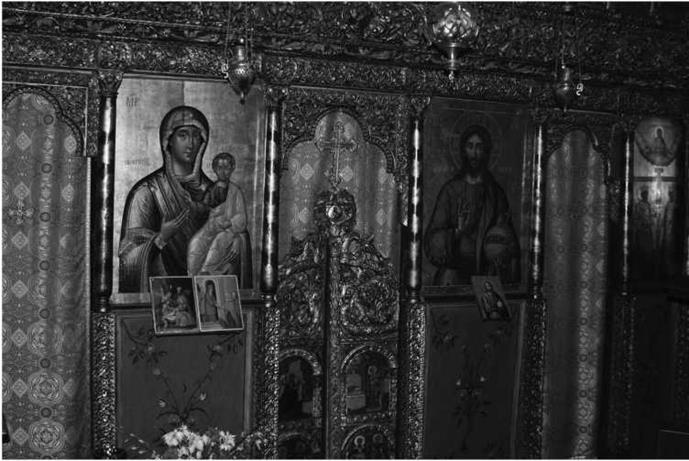Iconostasis
MARIA GWYN MCDOWELL
An icon screen demarcating the nave from the sanctuary. It originates from the π-shaped Byzantine templon, a low rail (easily seen over) eventually interspersed by columns topped by an architrave which served to marshal worshippers crowding around the altar. The earliest known examples are the archeological findings at Hagios Ioannes Studios (463) and descriptions of Hagia Sophia. As liturgical movement concentrated in the altar (ca. 9th century), icons were extended along the architrave though the partition remained transparent up until approximately the 13th century.
The vertical ascent and solidification of the iconostasis began in 14th-century Russia, perhaps influenced by contemporary theological conflicts. The resulting manytiered edifice that closes off the altar area subsequently became widespread. The first “local” tier of icons on the full Iconostasis includes the Royal Doors (usually the Annunciation) surmounted by the Mystical Supper or the Hospitality of Abraham. To the left (as one faces the screen) is the icon of the Theotokos, then the church’s patron saint, and the north (exit) door portraying either St. Michael or a deacon-saint, and then another patronal saint. On the right is the icon of Christ (usually the Pantocrator), then John the Forerunner, the south (entrance) door with Gabriel or a deacon-saint, and then another patron saint. Ascending tiers of icons usually include a Deisis, the Twelve Great Feast icons, and rows of prophets and patriarchs.
SEE ALSO: Ambo; Iconography, Styles of; Icons
REFERENCES AND SUGGESTED READINGS
Arida, R. M. (2008) “Another Look at the Solid Iconostasis in the Russian Orthodox Church,” St. Vladimir’s Seminary Quarterly 52: 339–66. Florenskii, P. A., Sheehan, D., and Andrejev, O. (1996) Iconostasis. Crestwood, NY: St Vladimir’s Seminary Press.
Ouspensky, L. (1964) “The Problem of the Iconostasis,” St Vladimir’s Seminary Quarterly 8: 186–218.

Plate 34 An icon-screen of an Orthodox church (iconostasis). Photo by John McGuckin.
